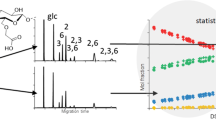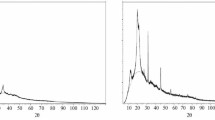Summary
All dansylaminoacids can be separated by 2 twodimensional chromatographies, combined with chromato-electrophoresis on cellulose powder. In all three cases, partition chromatography takes place, in the first dimension, on ammoniumsalts of dansylaminoacids in the solvent toluene/glycol chlorhydrine/pyridine/ammonia 0.8 N (150 ml : 90 ml : 45 ml : 90 ml), +200 mg of primary octyl alcohol. Separation of the ether-soluble compounds is obtained by “salting-out chromatography” in the second dimension: Water/water saturated with ammonium sulphate/sodium dodecylsulphate (700 ml/100 ml/576 mg). As for the dicarboxyl-dansylaminoacids, their separation is obtained, after a second partition chromatography, on a thin layer impregnated with sodium acetate (0.2 M), by means of the solvent isobutanol/acetic acid/water (150/3 to 5/20). Electrophoresis, in the second dimension (diethylamine 0.033 M; sodium chloride 0.02 M), permits the separation of the acid-soluble derivatives. Mixtures of dinitrophenyl-aminoacids and dansylaminoacids can be analyzed simultaneously.
Zusammenfassung
Alle Dansylaminosäuren können durch 2 zweidimensionale Trennungen in Verbindung mit der DC-Elektrophorese auf Celluloseschichten getrennt werden.
In allen drei Fällen wird eine Verteilungs-Chromatographie der Ammoniumsalze der Dansylaminosäuren vorgenommen, und zwar in der 1. Richtung mit dem Lösungsmittel: Toluol+Glycolmonochlorhydrin+Pyridin+0,8 N Ammoniak (150+90+45+90)+200 mg prim. Oktanol.
Die Trennung der ätherlöslichen Bestandteile wird durch die „erweiterte Chromatographie” in der 2. Richtung mit: Wasser+gesättigte Ammoniumsulfat-Lösung+Natriumdodecylsulfat (700 ml+100 ml+576 mg) erreicht. Die Dicarboxyl-dansylaminosäuren werden nach einer 2. Verteilungs-Chromatographie auf DC-Schichten, die mit 0,2 M Natriumacetat imprägniert sind, getrennt, mittels Isobutanol+Eisessig+Wasser (150+3−5+20). Eine Elektrophorese in 2. Richtung (Puffer: Diäthylamin 0,033 M/Natriumchlorid 0,02 M) erlaubt die Trennung der säurelöslichen Derivate. Die Analysen der Gemische von Dinitrophenylaminosäuren und der Dansylaminosäuren können auf diesem Wege gleichzeitig ausgeführt werden.
Sommaire
Tous les dansylaminoacides peuvent être séparès par deux chromatographies bi-directionnelles et une chromatoélèctrophorése sur couche mince de poudre de cellulose sans liant. Dans les trois cas, la chromatographie de partage, selon la premiére direction, est faite sur les sels d'ammonium des dansylamioacides dans le solvant toluéne/monochlorhydrine du glycol/ammoniaque 0,8 N. (150 ml. : 90 ml. : 45 ml. : 90 ml.) + alcool octylique primaire 200 mg. La séparotion des composés éthérosolubles est obtenue aprés la chromatographie de relargage selon la seconde direction: eau/eau saturée de sulfate d' ammonium/dodécylsulfate de sodium (700 ml. : 100 ml./576 mg.). Pour les dansylaminoacides dicarboxyliques, leur séparation est obtenue, aprés une seconde chromatographie de partage, sur couche mince imprégnée d'acétate de sodium (0,2 M.) à l'aide du solvant isobutanol/acide acétique glacial/eau (150∶3 à 5∶20). Une électrophorése, en seconde direction, (diéthylamine 0,033 M., chlorure de sodium 0,02 M.) permet de séparer les dérivés hydro-acidosolubles. Les analyses des mélanges de dinitrophénylaminoacides et de dansylaminoacides peuvent être faites simultanément.
Similar content being viewed by others
Abbreviations
- D:
-
radical dansyl
- Ala:
-
D-Alanine
- α Arg:
-
Nα-mono-D-Arginine
- Asp:
-
D-Acide aspartique
- Asp/NH2 :
-
D-Asparagine
- CySCM:
-
D-S-carboxymethylcystéine
- CySCM-O:
-
produit d'oxydation à l'air de la D-Cy/SCM
- CySO3H:
-
D-Acide cysteique
- di CySSCy:
-
di-D-Cystine
- di-His:
-
di-D-Histidine
- di-Lys:
-
di-D-Lysine
- DNH2 :
-
dansylamide
- DOH:
-
dansylacide
- di Tyr:
-
di-D-Tyrosine
- GLu:
-
D-Acide Glutamique
- Glu NH2 :
-
D-Glutamine
- Gly:
-
D-glycocolle
- Ileu:
-
D-Isoleucine
- Leu:
-
D-Leucine
- α-Lys:
-
N-α-mono-D-Lysine
- ∈ Lys:
-
N ∈ mono-D-Lysine
- Met:
-
D-Methionine
- MeSO:
-
D-Methionine sulfoxyde
- MeSO2 :
-
D-Methionine sulfone
- mono-CySSCy:
-
mono-D-Cystine
- N α mono His:
-
N-α-mono-D-Histidine
- N-im-mono His:
-
N-imidazole-mono-D-Histidine
- N-mono Tyr:
-
N-α-mono-D-Tyrosine
- O-mono-Tyr:
-
O-mono-D-Tyrosine
- Pser:
-
D-phosphoserine
- Phe:
-
D-Phenylalanine
- Pro:
-
D-Proline
- Ser:
-
D-Serine
- Thr:
-
D-Thréonine
- Try:
-
D-Tryptophane
- Val:
-
D-valine
Literature
Munier, R.L., etSarrazin, G., J. of Chromatography22, 336 et 347 (1966); Bull. Soc. chim. France 1965, 2959.
Munier, R.L., etSarrazin, G., Bull. Soc. chim. France 1490 (1965); 1365 et 1367 (1966); 3171, 3176, 3971 (1967).
Hartley, B.S., etGray, W.R., Biochem. J. 89-609 et 380 (1963).
Ces dérivés peuvent permettre le dosage des amino-acides par mesure de fluorescence après séparation sur colonne de polyamide (nylon 11) avec une solution benzénique ou toluénique d'acide acétique ou propionique ou de monochlorphydrine du glycol de concentration variable.
Sanger, F., Biochem. J.39, 507 (1945).
Morse, D., etHorecker, B.L., Anal Biochem.14, 429 (1966); Gros Cl., Bull. Soc. chim. France 3952 (1967); Galoyan A.A., Mesrob, B.K., Holeysovsky, V., J. chromato.24, 440 (1966).
Un procédé similaire de double marquage peut être applique aux hydrolysats partiels de dansyl-peptides ou de DNP-peptides.
Biserte, G. etOsteux, R., Bull.Soc. chim. Biol.33, 50 (1951).
Ces dansyl dérivés (ou les dansyl-peptides) peuvent être séparés des sels par passage sur colonne de granules de dextrane réticulé (Sepladex G 25).
Author information
Authors and Affiliations
Rights and permissions
About this article
Cite this article
Munier, R.L., Thommegay, C. & Drapier, AM. Séparation sur couche mince de poudre de cellulose des 1-dimethylaminonaphthaléne, 5-sulfonylaminoacides. Chromatographia 1, 95–97 (1968). https://doi.org/10.1007/BF02258941
Received:
Accepted:
Issue Date:
DOI: https://doi.org/10.1007/BF02258941




